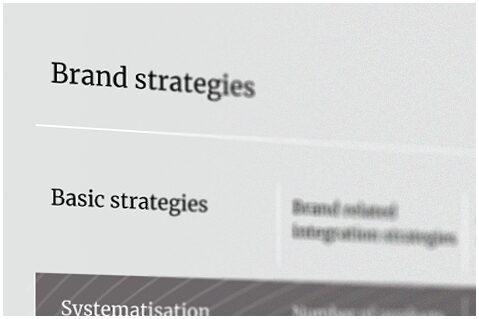Overview of brand strategies.
With the contribution “Significance of brands” it was stated that companies have to refine and deepen the brand idea. For this purpose, specifically selected brand strategies are to be implemented in a process, taking into account the possible opportunities and risks.
Which brand strategies are available to companies?
The following figure shows the basic strategies with the respective strategy alternatives of Sattler and Völkner, which have become established in practice over time.
The basis of the present differentiation was based on preliminary considerations regarding the number of products under one brand, the number of brands per product market, a reasonable combination of brand names as well as a geographic range and a possible or reasonable further development of existing brands over time.[1][2]
It is therefore the task of brand strategies to define the relationship between product performance and brand.[3]
Other authors only distinguish between three basic strategies[4][5] or assign brand positioning as a sub-area of the strategies.[6]
However, the breakdown into three basic strategies is less in line with reality and thus contradicts an active application in practice.
The positioning in turn is often taken as the starting point for brand strategies.
In the following, the individual strategies with their advantages and disadvantages are briefly presented.
Brand related integration strategies
According to Sattler and Völckner, the brand-related integration strategies comprise the mono- or single-brand strategy and the brand transfer strategy, which includes the umbrella and family brand strategy.
These brand strategies differ in the number of products under one brand and the differentiation between mono-brand and brand transfer strategy with regard to their respective degree of integration[1].
With the monobrand strategy the number is limited to one product per brand. This alternative is suitable for a company if the product range is very heterogeneous in itself and the target groups are addressed in clearly separable segments. A mono-brand often arises in connection with a new brand strategy, which is characterised by the fact that “for a new product, a completely new brand is developed from the point of view of potential customers”[2].
A brand transfer strategy is when at least two products are integrated under one brand, i.e. by transferring an established trademark to a new product.[3] Sattler and Völckner distinguish a total of six forms of brand transfer, which differ as follows:
- • by the number of brands per company (umbrella and brand family strategy), by the direction of the transfer (vertical and horizontal),
- • according to the product category, in terms of the way in which it is transferred (line, franchise extension or concept extension),
- • by type of origin (internally: own established brand and externally: licensing or merger & acquisition),
- • in terms of geographical reach or spatial transfer, and
- • according to the type of instruments used (product design, packaging and shelf design in retail outlets)[4].
I will gladly send you further, more detailed information on request.
Multi-brand strategies
While in market-based integration strategies the number of products under one brand is the systematisation criterion, multi-brand strategies are characterised by the number of brands on a product market that a company manages in parallel.
This strategy focuses on the delineation of product markets[5].
However, multi-brand strategies can also take the form of a mono-brand strategy or a single product market brand strategy if only one brand is offered in a separate market.[6]
The opportunities offered by multi-brand strategies compared with the single product market brand strategy include broader market coverage, securing the competitive position, the use of brand switching behaviour with low brand loyalty of the target group, greater market penetration or the more concentrated use of marketing instruments per market segment.[7]
Risks or dangers are, for example, the higher expenditure on communication measures as part of the marketing mix and the difficulties of segmentation, which leads to greater complexity and thus requires even greater coordination, as well as less flexibility in the overall brand strategy, and can result in cannibalisation among brands.[8]
I will gladly send you further, more detailed information on request.
Brand combination strategies
Characteristic of brand combination strategies is that two or more brands are offered together.
The difference between the single brand name strategy and the multiple brand name strategy is the number of brand names used[9].
The design forms of these combination strategies are diverse and can be divided into internal and external.
The internal combination strategies deal with the relationship of the brands to each other, i.e. the hierarchy and its arrangement, the brand architecture. “Brand architecture involves the arrangement of all brands with the aim of defining their specific roles and positioning and the [hierarchies] desired between the brands”[10] Such complex architectures are becoming increasingly common, as a number of approaches to structuring brand architecture have been developed in recent years. One recommendable approach is, for example, the work of Aaker and Joachimsthaler[11].
External brand combination strategies are differentiated between Sattler and Völckner according to the criterion of the number of brand suppliers.
The offer of several brands from one supplier is easy to understand.
The offer of several suppliers is to be explained on the basis of the concept of a brand alliance.
Brand alliances describe the joint appearance of at least two independent brands, the design of which can be summarised for the participating companies as follows: Co-promotions as joint promotion activities of brands, co-advertising as joint advertising activities of brands, co-branding as a horizontal combination of brands for a joint branding of a product, ingredient branding in the case of a vertical combination, and company cooperations and mergers and acquisitions as a special case.[12]
The chances of multi-brand strategies are that an additional benefit can be created for the consumer, that the image of the individual brands can be strengthened, that easier access to the retail trade can be achieved and that broader and more intensive customer loyalty can be the result.[13]
On the other hand, there are risks such as an increased coordination effort, a limited flexibility of action, as the concerns of the partner company have to be taken into account, the risk of a change in the position of the partner brand and the resulting possible damage to its image.[14]
I will gladly send you further, more detailed information on request.
International brand strategies
International brand strategies refer to the geographical reach of the brand offering in regional, national, international and global markets. These strategies focus on the availability of resources, competitive behaviour and the political-legal and technological framework.[15] The planning of international brand management has to follow a planning process that starts with a situation analysis, followed by basic planning with its elements of brand selection and brand positioning and ends with the implementation of the international brand strategy or control.[16] The planning of an international brand management has to follow a planning process that starts with a situation analysis, followed by basic planning with its elements of brand selection and brand positioning and ends with the implementation of the international brand strategy or control.[16]
The two characteristics of standardisation and differentiation of brand positioning are therefore recognisable as special features in relation to the brand and the content of the strategy.
The extreme of standardisation would be that the brand is a global brand with a globally identical brand label, with an equally globally identical positioning and brand knowledge structure.[17]
The extremes of differentiation are completely contradictory.
In practice, it is easy to imagine that one of the extremes cannot be found in its pure form. One may rather assume that a mixed form is the rule, which is characterised by the determinants outlined by Sattler and Völckner, such as, among others, the protectability of brands, media spillover, basic corporate strategy and demand behaviour, taking into account country-specific cultural events.[18]
From the opposite poles, the advantages of standardization can be clearly and comprehensibly identified as cost degression, the use of synergy effects and the development of the brand into a global brand and thus the increase in brand value.[19]
The reverse effect of the determinants mentioned above would result in the disadvantages of standardisation or the advantages of differentiation. One particular point is that a high degree of standardisation means that target groups can be addressed less specifically and brand potential could therefore not be fully exploited[20].
I will gladly send you further, more detailed information on request.
Brand evolution strategies
Brand evolution strategies include brand consolidation in the form of the brand elimination strategy and the brand migration strategy.
In brand elimination, weak brands are skimmed off and taken out of the market in order to optimise the value of the entirety of the brands, the brand portfolio.[21] Also in the context of brand policy, it is important to analyse the existing compound effects, to evaluate them objectively and correctly so that the horizontally and/or vertically arranged brands are not negatively influenced.
In the brand migration strategy, one brand is transferred into another, whereby the performance range of the brand is largely retained, but the marking such as the brand logo or the lettering is completely replaced.[22]
The brand expansion strategy involves a brand transfer or geographical expansion,[23] which can be dealt with using the basic strategies already mentioned.
Brand revitalisation describes the process, also explained above, of reintroducing a brand that has been temporarily withdrawn from the market[24].
I will gladly send you further, more detailed information on request.
[1][2][3][4][5][6][7][8][9][10][11][12][13][14][15][16][17][18][19][20][21][22][23][24] See Sattler / Völckner (2013)
I will be happy to send you the detailed bibliography on request.



